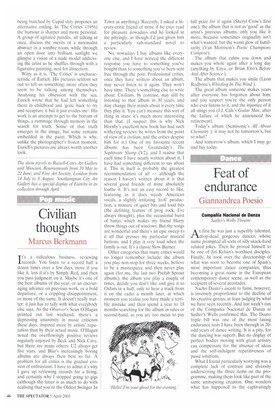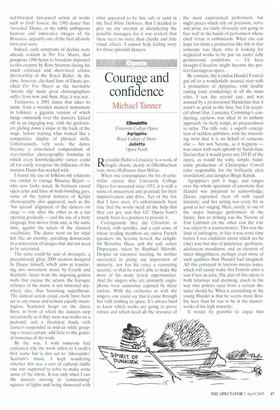Feat of endurance
Giannandrea Poesio
Companfa Nacional de Danza Sadler's Wells Theatre
At first he was just a superbly talented, drop-dead gorgeous dancer, whose name prompted all sorts of silly snack-food related jokes. Then he proved himself to be one of Jiri Kylian's worthiest disciples. Finally, he took over the directorship of what was soon to become one of Spain's most important dance companies, thus becoming a great name in the European contemporary dance scene, as well as the recipient of several accolades.
Nacho Duato's ascent to fame, however, is inversely proportional to the decline of his creative genius, at least judging by what we have seen recently. And last week's run of the Compania Nacional de Danza at Sadler's Wells confirmed this. The Duato triple bill was one of the most taxing endurance tests I have been through in 20odd years of dance writing. It is a pity, for the dancing was superb. But no display of perfect bodies moving with great artistry can compensate for the absence of ideas and the self-indulgent repetitiveness of passe solutions.
What I found particularly worrying was a complete lack of contrast and diversity underscoring the three items on the programme, making them look like part of the same uninspiring creation. One wonders what has happened to the captivatingly red-blooded, fast-paced action of works such as Jardi Tancat, the 1983 dance that 'revealed' Duato, or the subtly ambiguous humour and innovative images of his Remanso, arguably one of the best all-male trios ever seen.
Indeed, early symptoms of decline were already evident in Por Vos Muero, that pompous 1996 hymn to boredom imported to this country by Ross Stretton during his much criticised and short-lived artistic directorship of the Royal Ballet. At the time, however, die-hard fans of Duato justified Por Vos :Velcro as the inevitable 'artistic slip' many great choreographers suffer from now and then. Alas, it was not.
Txalaparta, a 2001 dance that takes its name from a wooden musical instrument in folklore, a gigantic version of which hangs ominously over the dancers, kicked off in an engaging way, with the performers gliding down a slope at the back of the stage, before starting what looked like a competitive display of physical skills. Unfortunately, very soon, the dance became a convoluted compendium of over-familiar choreographic formulae in which every knowledgeable viewer could all too easily recognise the influence of the masters Duato has worked with.
I found the use of folklore-ish solutions too similar to vintage Maurice &jail — who now looks dated. In between raised open arms and lines of male-bonding guys, some of the typical features of Kylian choreography also appeared, such as the 'fan spread' alignment of the dancers on stage — one after the other as in a fan opening gradually — and the use of a body language that moves from and, at the same time, against the tenets of the classical vocabulary. The dance went on for what felt like an eternity, spiralling downwards in a reiteration of images that did not need to be reiterated.
The same could be said of Arcangelo, a pretentiously glitzy 2000 creation designed by Duato himself, which aims at translating into movement music by Corelli and Scarlatti. Apart from the imposing golden walls that encase the action, the baroque richness of the music is not mirrored anywhere else, thus becoming superfluous. The danced action could easily have been set to any music and remain equally meaningless. Scattered heaps on the dance floor, in front of which the dancers stop occasionally as if they were wax works on a pedestal, and a theatrical finale with dancers suspended in mid-air while grasping a raised curtain, add little to the general nonsense of the work.
By the way. I wish someone had explained why the work refers to Corelli's first name but is also set to 'Alessandro' Scarlatti's music. I kept wondering whether this was a sort of cultural riddle one was supposed to solve to make some sense of the whole. It was only when I saw the dancers moving in 'constraining' squares of lights and being showered with what appeared to be fine salt or sand in the final White Darkness, that I decided to give up any attempt at deciphering the possible messages, for it was evident that these were no more than cheeky and trite visual effects. I cannot help feeling sorry for those splendid dancers.



































































 Previous page
Previous page